Leduc, Alberta 作者: 来源: 发布时间:2021-07-21
I.Population and Area
₋Area
Land: 42.44 km2 (16.39 sq mi)
₋Population (2016)
Total: 29,993
Density: 706.7/km2 (1,830/sq mi)
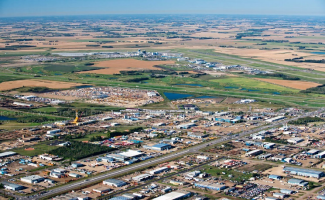
II.Natural Geography
₋Leduc is a ci ty in the province of Alberta, Canada. It is 33 km (21 mi) south of the provincial capital of Edmonton and is part of the Edmonton Metropolitan Region.
₋Leduc has a wide variety of parks and sports amenities, and has more than 35 km (21.7 mi) of multiuse pathways. On the east end of the city lies Telford Lake, and just to the east is Saunders Lake.
Alexandra Park Ponds
Coady Lake
Leduc Reservoir
Telford Lake
West Point Lake
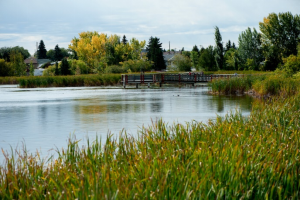
III.Economy
₋The average salary in Leduc, Alberta is C$22.10. Trends in wages decreased by -100.0 percent in Q1 2020. The cost of living in Leduc, Alberta is 100 percent higher than the national average. The most popular occupations in Leduc, Alberta are Licensed Practical Nurse (LPN), Office Manager, and Administrative Assistant which pay between C$14.85 and C$40.59 per year. The most popular employers in Leduc, Alberta are Alberta Health Services, Extendicare Canada Inc, and Holiday Inn.
₋Website: https://www.payscale.com/research/CA/Location=Leduc-Alberta/Salary
IV.Industrial Characteristics
₋Energy
₋The energy sector and energy related businesses have been critical to economic growth in Leduc and Alberta’s International Region. As a result, the region has evolved into an integral center for the growth of Alberta and Canada’s economy. Aggressive new investment and innovation have been pivotal to the region’s success. New investment has led to rapid growth in the sub-sectors of clean and renewable technologies. Seventy primary and support companies have located in Leduc to build this sector to what it is today. They support drilling and exploration activities in the oil sands and around Alberta. These companies benefit from the region’s strategic location and excellent highway, air and rail infrastructure.
₋Advanced Manufacturing
₋Advanced manufacturing is an established, vital sector in the Leduc economy. The sector is comprised of more than 70 companies utilizing new technology and the efficiencies of lean production to realize advances in energy, chemical, equipment, and metal fabrications.
₋Sectors such as transportation complement and support the needs of the manufacturing sector. Leduc provides an ideal environment to foster this growth with access to research, expertise and supportive industry leadership that has made the city a global trailblazer.
₋Logistics
₋Leduc is a nexus for transportation and logistics both domestically and globally. Port Alberta, a hub which ties the transportation infrastructure together with the services of customs brokers, third-party logistics service providers and a cargo village within a free-trade zone, provides Leduc immeasurable advantages in accessibility and distribution. The Edmonton International Airport, the primary air passenger and air cargo facility in the region, is situated 10 minutes from Leduc. The airport handles more than 8,000,000 passengers a year with more than 30,000 tonnes of freight passing through its doors a year. Two railways, Canadian Pacific and Canadian Nation, transport goods to markets and ports east as well as to the ports in British Columbia and markets in the United States. A network of highways – the Trans Canada which runs east
₋and west from coast to coast, and the Queen Elizabeth II which runs north and south and links Alberta to the CanMex Corridor – strengthens Leduc’s access to outlying markets. This ground infrastructure supports access to three ports along the Pacific Ocean: Port Metro Vancouver Deep-sea Terminal, Port Alberni, and the Port of Seattle. Each of these ports handles high volumes of traffic and has direct access to Asian markets.
₋Website: https://www.leduc.ca/opportunity/industrial-development
V.Attractions
1.William F. Lede Park
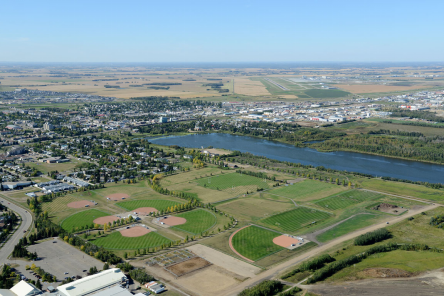
₋William Lede was the owner of Leduc Construction (now Ledcor Group) in 1947 and prepared the drilling site for Imperial Oils Leduc No. 1. Lede was elected to Leducs City Council in 1956 and served four terms as Mayor, from 1968 until his death in 1980.
₋Website: https://www.leduc.ca/william-f-lede-park
2.Telford Lake
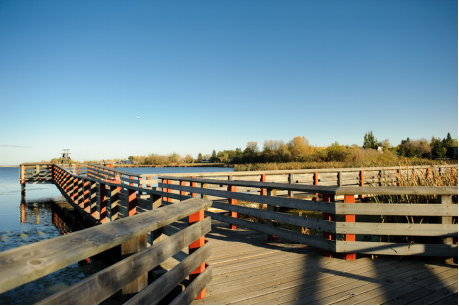
₋Telford Lake is a lake in Leduc, Alberta.It is home to boat races and many other events. Around 1890, Robert Telford, a politician from Quebec, bought a plot of land near the lake. The lake was later named for him. There are many species of wildlife in the Telford Lake riverbanks. Conservation projects are numerous in Telford Lake.
₋Website: https://www.leduc.ca/telford-lake
3.DR. Woods House Museum
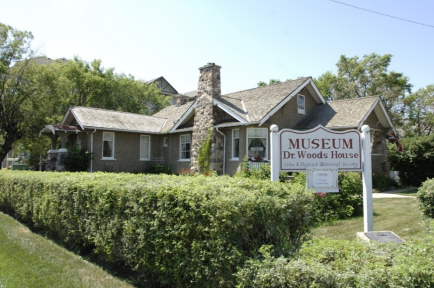
₋Robert Theodore Woods was born November 7, 1870 in London, Ontario. He attended Western University and graduated in 1895. He practiced medicine in Kansas where he resided until 1902. In that year he came to the Leduc district in Alberta and homesteaded in the Telfordville area west of Thorsby.
₋Dr. Woods did a lot of veterinary and medical work for the pioneers in the area. When Alberta became a province in 1905, Dr. Woods decided to resume his medical practice, but required a license. His neighbours, with the help of MLA Robert Telford, helped him obtain his license by petitioning settlers as far away as Calmar. Each person who signed agreed to pay Dr. Woods $2.00 a year for his services. Early in 1908, Mr. Telford sponsored a private Member’s Bill in the Alberta Legislature to allow Robert Woods of Strawberry Creek to practice medicine. Five months later, Dr. Woods moved his family to Leduc, where his mother Mattie, sisters Emma Jane and Kathleen (a school teacher) and sister Martha Louise and brother-in-law Dr. James Baker already lived.
₋Dr. Woods married Olive Hopkins of Kansas in 1903. For the next five years the Woods’ homesteaded on Strawberry Creek near Telfordville. Their first child, Edwin, was born there in 1905. Sometime later another son was born, but unfortunately died from a fall off a horse. The family moved into the town of Leduc when Dr. Woods obtained his medical license, and daughter Marion was born there in 1915.
₋As a rural doctor, Dr. Woods faced many difficult situations with few medicines and inadequate facilities. He was a strong believer in cleanliness; he felt that homesteaders, with fresh air and soap and water, could reduce illness. With no telephones, Dr. Woods travelled many miles to visit his patients, day or night regardless of weather conditions. In winter he donned his buffalo coat and fur gauntlets and went out with horse and cutter. In later years he travelled to attend his patients in his Hupmobile during the summer months. During the Spanish Flu epidemic of 1918 Dr. Woods worked day and night with little more than aspirin to treat this dreaded disease.
₋Dr. Woods had hospital privileges at the old Misercordia Hospital in Edmonton, often taking patients in by train. Often new settlers, unable to pay doctor’s bills, would give Dr. Woods a few chickens, butter, eggs, milk or a bag of potatoes for his services.
₋In 1923 Dr. Woods was granted a certificate from the Medical Council of Canada, which entitled him to practice anywhere in Canada.
₋For a time Dr. Woods had his office above the Harness Shop on Main Street, then in his home on Freeman Avenue, now 48th Street, across from the Junior High School. In 1927, Dr.Woods bought the lot of the present Museum from Mr. John Flood and built a modern Craftsman style bungalow with an attached medical wing. The lot had been the site of the first Merchants Bank of Canada until Mr. Flood purchased it in 1904. The stones in the fireplace and in the front porch pillars, prominent features of a Craftsman bungalow, were hauled in by horse and wagon from their original homestead at Telfordville. The Woods family moved into their new home in the fall of 1927.
₋Dr. and Mrs. Woods were a well admired couple in the community. Dr. Woods served on the town council and also as medical health officer and coroner for the town of Leduc and the municipal districts of Liberty and Black Mud. He took an active interest in politics and for a number of years was president of the Leduc Conservative Association. Dr. Woods belonged to various lodges of the day: the Orange Lodge, the American Woodmen, the Canadian Order of Foresters and the Moose Lodge. In 1932, Dr. and Mrs. Woods were honored to lead the Grand March at the opening of the Calmar Hall, an event attended by over 700 people from Edmonton, Thorsby, Leduc, and Wetaskiwin.
₋Dr. Woods enjoyed gardening; his yard was full of trees, flowers and shrubs. He particularly enjoyed grafting roses and his rose beds were considered most admirable.
₋Dr. Woods enjoyed his practice, and his family. Thanks to his uniquely designed home, he died within a few feet of his office on Wednesday April 22, 1936 at the age of 65. Dr. Woods is buried in the Edmonton Cemetery.
₋After the death of Dr. Woods, Mrs. Olive Woods sold the home on 4801-49th Ave in Leduc in 1936 to Mr. McCready. The home actually went through four owners before the city of Leduc bought it back in 1982. The Leduc and District Historical Society renovated the home and operate the Museum to the present day. In 1993, Dr. Woods House Museum was designated an Alberta Registered Historic Site, and in 2008, an Alberta Municipal Historic Site.
₋There are several interesting footnotes in the intervening years between the Woods’ residence and the City’s ownership. This building was home to MLA Ronald Earle Ansley during the late 1930’s. Mr. Ansley was known at the time for helping spearhead the backbencher’s revolt against Alberta Premier William Aberhart. In the early 1940’s, this modest bungalow was actually home to three families at once: one family lived on the main floor, another in the medical wing, and a third in the garage – now the tea room. In later years, the upstairs attic was used as sleeping quarters for a number of children when large families owned the home.
₋The Leduc and District Historical Society mandate was to restore the home to depict the domestic and professional life of Dr. Robert Woods, a pioneer doctor of the area. The Museum collects, preserves, researches, exhibits and interprets artifacts reflecting the period of life from the late 1920’s to the early 1940’s shown in a Canadian doctor’s home in a small prairie town.
₋The Museum building itself remains a fine example of the Craftsman style of architecture of the 1920’s. The exterior of the Museum communicates these ideals with the pebble dash stucco walls, low-pitched roof with cedar shingles, and welcoming veranda entrances. Each room in the house has been restored and furnished according to information received from Marion, Dr. Woods’s daughter, in detailed correspondence. The Art Deco period of decoration is particularly strongly represented.
₋The Leduc and District Historical Society have given a tremendous amount of time in this huge endeavor. The restoration of the building, the acquisition of artifacts with the proper conservation and handling involved, the cataloguing, displaying and management of all resources was a multi-year commitment on the part of many volunteers. The presentation of living history through a museum gives us all a place of pride, a sense of place and an identity in our world. The Leduc and District Historical Society have done an invaluable service to our community in the preservation of Dr. Woods House Museum.
₋Address: 4801 49 Ave, Leduc, AB T9E 7G6
₋Phone: (780) 986-1517
₋Website: https://www.drwoodsmuseum.com/
VI.History
₋Leduc was established in 1899, when Robert Telford, a settler, bought land near a lake which would later bear his name. It was on that piece of land where the new settlement would take root. Telford previously served as an officer for the North-West Mounted Police, and later became Leduc's first postmaster, first general merchantman, and first justice of the peace.
₋The establishment of the Calgary and Edmonton Railway, later acquired by the Canadian Pacific Railway, opened the region to settlement. The first train stopped at Leduc in July 1891.
₋Originally there were two versions to describe how Leduc got its name. In fact both accounts are true. In April 1886 when a settler (McKinley) setting up a telegraph office needed a name for the new station and decided that it would be named after the first person who came through the door of the telegraph office. That person was Father Hippolyte Leduc, a priest who had served the area since 1867. Five years later, in 1891, the Minister of the Interior and Superintendent of Indian Affairs, who had been Lieutenant-Governor of the North-West Territories, Edgar Dewdney (1835–1916), was given a list of names, that had been provided to the railroad by Father Lacombe, decided that Telford Place should be renamed at the time the railway terminal was being established. Father Leduc's name was on the list and since the telegraph station was all ready called Leduc Dewdney saw no reason why not to use Leduc's name for the new railroad station and the hamlet that was growing alongside .
₋Leduc was incorporated as a village in 1899, and became a town in 1906. It became a city in 1983; by that time its population had reached 12,000.
₋The town continued to grow quietly over the decades and Alberta's historical oil strike on February 13, 1947, occurred near the town at the Leduc No. 1 oil well.
VII.Other Information
₋Economy
₋The City of Leduc is a founding member of the Leduc-Nisku Economic Development Association, an economic development partnership that markets Alberta's International Region in proximity to the Edmonton International Airport. The city forms part of this international transportation and economic region. It is on the CANAMEX Trade Corridor at the intersection of two Canadian Pacific Railway lines and is adjacent to the Edmonton International Airport. These transportation links support the petrochemical activities in Alberta's Industrial Heartland, the Fort McMurray area, and other economic hubs.
₋The oil and gas industry has long been the base of Leduc's economy. The Leduc Business Park, in the northern portion of the city, contains more than 1,400 businesses. The Nisku Industrial Park, located to the north within Leduc County, also contains many businesses.
₋Arts and culture
₋Leduc is home to the Maclab Centre for the Performing Arts, a preeminent performing arts facility with a 460-seat theatre.
₋In fall 2009, the Leduc Recreation Centre was opened. The 309,000 sq ft (28,700 m2) facility includes three NHL-sized arenas, an aquatic centre, and a curling rink.
VIII.Contact Information
₋Government
Mayor: Bob Young
Governing body: Leduc City Council
₋City Hall
₋Address:
#1 Alexandra Park
Leduc, AB T9E 4C4
(Mon - Fri: 8:30 a.m. - 4:30 p.m.)
₋Main Reception: 780-980-7177
₋Website: https://www.leduc.ca/contact-us
